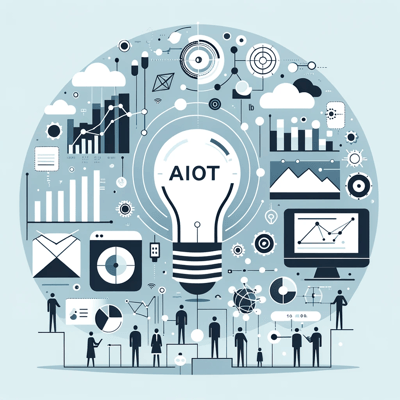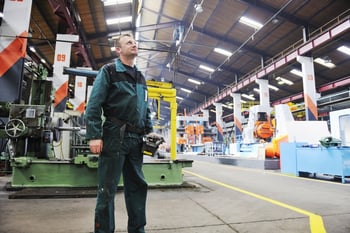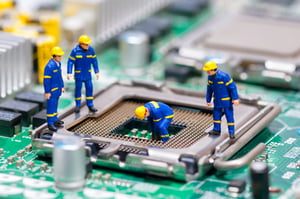Envision an office, factory, or solution where every device seamlessly caters to the needs of employees, without requiring any explicit instructions. Picture routines that are optimized by a synchronized network of interconnected devices, each operating autonomously yet in harmony, to create the perfect workday or the perfect manufacturing run:
This is the promise of the AI Internet of Things, or AIoT, a paradigm shift in connectivity.
By embedding artificial intelligence into IoT and its industrial subset IIoT, AIoT transforms passive devices into active assistants, capable of predictive and adaptive behaviors that refine user interactions, enhance efficiency, and personalize experiences.
The fusion of AI and IoT—AIoT—represents a confluence of digital intellect and network ubiquity, leading to the optimized integration of myriad sensors, devices, and data streams into a seamless, efficient solution. Through AIoT, the true potential of autonomous decision-making is harnessed, optimizing operations in real-time and minimizing human intervention. This convergence paves the way for smart ecosystems, where predictive maintenance and energy management become the norm—evolving beyond mere automation into intelligent, interconnected environments that anticipate needs and proactively adapt to enhance operational efficacy.
This synergy between AI and IoT is an evolutionary leap in systems convergence, and it is fundamentally altering the world of connected solutions. AIoT is catalyzing unprecedented levels of automation, delivering intelligent solutions that redefine user interactions and efficiency. As intelligent algorithms ingest and analyze data from IoT devices, the resulting insights drive proactive actions and informed decisions, setting new benchmarks in responsiveness and customization.
Harnessing both AI's predictive prowess and IoT's sensor network and data collection capabilities yields a landscape where devices not only communicate but anticipate needs, creating a user-centric paradigm of smart interconnections.
 Efficient integration of AI and IoT promises cohesive smart environments that seamlessly respond to and predict user preferences.
Efficient integration of AI and IoT promises cohesive smart environments that seamlessly respond to and predict user preferences.
These environments typically operate with a level of autonomy that enhances operations without obtrusive user input, epitomizing convenience. Additionally, streamlining processes through AIoT culminates in robust, adaptive systems that not only connect but also evolve with business or employee needs, further improving operational efficiencies.
The integration of Artificial Intelligence of Things (AIoT) in business creates numerous cost savings and revenue opportunities. This transformative technology offers businesses a competitive edge by optimizing operations, enhancing customer experiences, and unlocking new business models. Let's delve into the potential benefits of AIoT in terms of cost savings and revenue opportunities:
AIoT has brought transformative changes to industry operations. Through the integration of smart sensors and advanced analytics, AIoT enables unparalleled visibility and control within the industrial setting. This synthesis of technologies accelerates operational efficiency, ensures equipment longevity, and enhances overall safety protocols—a quantum leap in industrial management.
 Incorporating AIoT platforms transforms traditional production lines into intelligent, self-optimizing systems -- the much-sought-after "smart factories.” Here, every piece of equipment, every sensor, and every machine-to-machine communication is a data point in a self-regulating ecosystem. Predictive maintenance strategies become the norm, optimizing equipment performance and dramatically reducing downtime. In effect, the confluence of AI and IoT has not just upgraded the industrial processes; it has redefined what is possible within the domain of manufacturing and supply chain operations.
Incorporating AIoT platforms transforms traditional production lines into intelligent, self-optimizing systems -- the much-sought-after "smart factories.” Here, every piece of equipment, every sensor, and every machine-to-machine communication is a data point in a self-regulating ecosystem. Predictive maintenance strategies become the norm, optimizing equipment performance and dramatically reducing downtime. In effect, the confluence of AI and IoT has not just upgraded the industrial processes; it has redefined what is possible within the domain of manufacturing and supply chain operations.
Predictive maintenance epitomizes the proactive ethos of AIoT, harnessing data to prevent unplanned downtime. Utilizing AI and historical data, systems can forecast equipment failure, enabling preemptive intervention and repairs. Such foresight drastically curtails maintenance costs and extends asset lifecycle.
How does it work? Early warning signals are key to predictive maintenance efficacy. AI analyses sensory inputs, detecting anomalies that precede equipment failure long before they escalate. In effect, AIoT transforms maintenance from a reactive to a proactive task. By consolidating performance data (vibrations, temperature, acoustics, etc.) with machine learning, potential issues are flagged before they disrupt operations.
This proactive approach also aligns with sustainable operational practices. By predicting and preventing issues rather than reacting post-factum, resources are conserved, waste is reduced, and the environmental footprint of industrial activities is minimized.
 Moreover, the ripple effect of AIoT-enabled predictive maintenance can enhance entire production ecosystems. By providing actionable insights into when equipment will require attention, production schedules and labor can be optimized, ensuring that the machinery and workforce operate at peak efficiency.
Moreover, the ripple effect of AIoT-enabled predictive maintenance can enhance entire production ecosystems. By providing actionable insights into when equipment will require attention, production schedules and labor can be optimized, ensuring that the machinery and workforce operate at peak efficiency.
Ultimately, the goal is to maximize a facility's uptime. Advanced predictive analytics and AI-driven insights not only safeguard production cadence but also promulgate a culture wherein asset reliability is paramount.
AIoT is a paradigm shift in how resources are managed and optimized. This smart integration facilitates granular control over resource consumption, reducing unnecessary expenditure and maximizing efficiency. Thus, incorporating AI with IoT devices enables a data-driven strategy for resource allocation, ensuring that every watt of energy and liter of water is judiciously utilized. Intelligent systems can predict demand fluctuations and adjust resources in real-time to meet the precise needs of any given moment.
The critical interplay of IoT sensors and AI algorithms creates a network that autonomously optimizes energy usage and operational costs. By monitoring environmental conditions and machinery performance, the system can make adjustments to conserve energy without compromising productivity.
Data visualization tools, empowered by AIoT, provide managers with actionable intelligence to make informed decisions about resource distribution. This prevents overallocation and fosters a lean operational environment that thrives on the principle of ‘less is more’. Such optimized resource management is the cornerstone of sustainable industrial practices, creating a synergy between economic gains and environmental stewardship. AIoT stands as a catalyst for achieving this equilibrium in a connected world.
In the era of AIoT, the imperative to secure interconnected devices against potential threats cannot be overstated. It demands a preemptive approach to security, one that incorporates real-time threat detection, AI-driven predictive analytics, and robust encryption methods that evolve in tandem with emerging vulnerabilities. This convergence of AI and IoT necessitates a dynamic security paradigm that is adaptable, resilient, and sophisticated enough to thwart advanced cyber threats, ensuring the integrity and reliability of the AIoT ecosystem. Implementing these comprehensive security strategies is crucial for safeguarding networks, devices, and data.
AIoT architecture deploys advanced algorithms for constant surveillance and anomaly detection. By integrating machine learning capabilities, AIoT systems anticipate and neutralize threats before they escalate into breaches, enhancing overall security posture. As AIoT becomes increasingly intertwined with critical infrastructures, the systems must proactively adapt to counteract evolving cyber threats, maintaining the security of data and operations. Real-time AI threat intelligence like that built into the Sentinel IoT management platform is transforming traditional reactive security measures into a more resilient, preemptive defense mechanism. To remain vigilant, AIoT platforms must continuously learn from incidents, ensuring protection against future threats with minimal human intervention. This iterative learning process enables AIoT systems to stay one step ahead, constantly evolving and strengthening their security measures to safeguard businesses from emerging risks and vulnerabilities.
Encryption serves as the bedrock of data security within AIoT realms, transforming sensitive information into unreadable cipher text. Robust encryption algorithms deter unauthorized access, providing a foundational layer of data protection.
In AIoT systems, encryption safeguards data both at rest and in transit. Incorporating complex encryption methodologies, such as Advanced Encryption Standard (AES) and elliptic-curve cryptography (ECC), strengthens the AIoT framework against sophisticated cyber assaults. These encryption standards are conceived to withstand a multitude of attack vectors, preserving the confidentiality and integrity of data streams across diverse AIoT applications.
Furthermore, the dynamic nature of AIoT necessitates adaptive encryption protocols. As devices proliferate and evolve, scalable encryption mechanisms must be ingrained within each AIoT node. This approach ensures that as the ecosystem expands, encryption capabilities simultaneously intensify, preventing any weak links in the security chain.
In conclusion, AIoT systems necessitate uncompromising encryption practices to assure a secure and trusted environment. As we witness a confluence of increasingly connected devices, the importance of deploying cutting-edge encryption methods cannot be overstated. Only through rigorous encryption standards can AIoT infrastructures hope to achieve the stringent security required to operate with confidence in an evermore connected and potentially vulnerable digital landscape.
Have questions about AIoT, our IoT developer kits, connectivity for your IoT solution, or Sentinel, our industry-best IoT device management and cybersecurity platform? Answers await:



